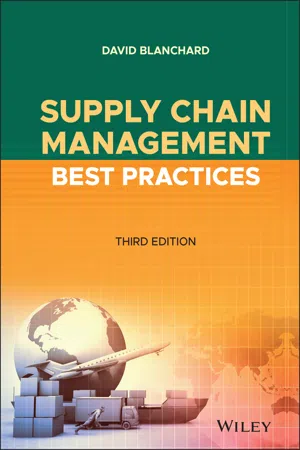
Supply Chain Management Best Practices
David Blanchard
- English
- ePUB (mobile friendly)
- Available on iOS & Android
Supply Chain Management Best Practices
David Blanchard
About This Book
SUPPLY CHAIN MANAGEMENT BEST PRACTICES
Although the fundamentals of the supply chain industry remain constant, massive shifts in the demands of the marketplace and powerful new technologies have changed the way supply chain and transportation companies must engage with and deliver solutions to their clients.
In the newly revised Third Edition of Supply Chain Management Best Practices, noted journalist and supply chain expert David Blanchard delivers a compelling and comprehensive overview of the new technologies shaping the transportation and supply chain industries today and the processes that will transform them tomorrow.
You'll discover a thorough introduction to supply chain management, along with examples of best-in-class supply chains in a variety of industries. You'll also find proven methods and KPIs for measuring the performance of a supply chain. The author presents the traditional core processes of supply chain management and discusses the techniques used by individual and trendsetting companies from around the world. Finally, you'll learn about the strategies, solutions, and technologies used by leading companies to design their global organizations.
From drones and the Internet of Things to same-day delivery, omni-channel distribution, artificial intelligence, Uber-style freight transportation apps, blockchain, and robotics, the book discusses how the transfer of computing power from central mainframes into smartphones and cloud-based services has enabled game-changing technologies to reach companies of all shapes and sizes.
Perfect for supply chain managers and professionals, chief financial officers, chief information officers, and controllers, Supply Chain Management Best Practices will also earn a place in the libraries of manufacturing, warehouse, and purchasing managers who seek a one-stop resource to help them understand the latest trends and the enduring foundations of the supply chain industry.
BUILD BEST-IN-CLASS SUPPLY CHAIN CAPABILITIES IN YOUR ORGANIZATION WITH THIS NEWLY UPDATED RESOURCE FROM AN INDUSTRY LEADER
The revised and updated Third Edition of Supply Chain Management Best Practices offers readers an insightful and comprehensive take on the concepts, processes, and technologies that define today's supply chain and transportation industries. You'll discover must-know information about traditional and core processes, as well as new technologies like drones, the Internet of Things, same-day delivery, and artificial intelligence that are transforming the industry.
The book contains valuable case studies, stories, and recent examples from real organizations implementing exciting new supply chain initiatives that are changing the way professionals think about their field. You'll find proven methods for measuring the performance of supply chains and insights into the strategies, solutions, and technologies used by trendsetting companies across the world. Finally, you'll learn why the transfer of computing power from central mainframes to the cloud and handheld devices has fundamentally changed the supply chain industry.
Ideal for executives, controllers, supply chain managers and professionals, as well as manufacturing, warehouse, and purchasing managers, the Third Edition of Supply Chain Management Best Practices remains an indispensable resource for anyone seeking to maintain and optimize a supply chain that functions as a competitive advantage.
Frequently asked questions
PART 1
Introduction to Supply Chain Management
CHAPTER 1
If Supply Chain Is the Answer, Then What's the Question?
Flashpoints
- A supply chain is the sequence of events that cover a product's entire lifecycle, from conception to consumption.
- A “one size fits all” supply chain strategy is doomed to failure.
- Although the modern concept of supply chain management dates back to the early 1980s, very few companies have fully embraced it.
- Building a best-in-class supply chain requires money, time, talent, energy, focus, commitment, and guts.
You Knew This Job Was Dangerous When You Took It
The Big Picture
Table of contents
- Cover
- Table of Contents
- Title Page
- Copyright
- Dedication
- Preface
- Acknowledgments
- PART 1: Introduction to Supply Chain Management
- PART 2: Traditional Core Processes of Supply Chain Management
- PART 3: Supply Chain Strategies
- About the Author
- Index
- End User License Agreement